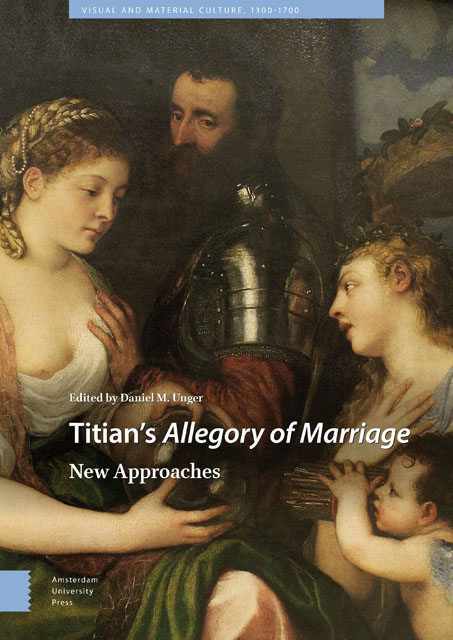Book contents
- Frontmatter
- Table of Contents
- List of Plates and Figures
- 1 Introduction: Poetic License
- 2 Love, Beauty, and the Human Body as a Reflection of the Divine
- 3 Amorosa visione: Titian’s Allegory of Marriage and the Poetry of the Half-length Format
- 4 The Arms and Armour of Titian’s Allegory of Marriage
- 5 ‘Un disio sol d’eterna gloria e fama’: A Literary Approach to Titian’s Allegory
- 6 Psyche, Venus, Ceres and Their Friends: Titian’s Remixes
- 7 Art and the Double Meaning of Reflection in Titian’s Allegory of Marriage
- 8 Titian’s Allegory of Marriage as an ‘Allegory of Peace’
- 9 Vision and Touch in the Allegory of Marriage
- 10 Of Crystal Orbs and Divinatory Mirrors : The Vicissitudes of Pregnancy and Artistic Agency in Titian’s Allegory of Marriage
- Index
7 - Art and the Double Meaning of Reflection in Titian’s Allegory of Marriage
Published online by Cambridge University Press: 16 November 2022
- Frontmatter
- Table of Contents
- List of Plates and Figures
- 1 Introduction: Poetic License
- 2 Love, Beauty, and the Human Body as a Reflection of the Divine
- 3 Amorosa visione: Titian’s Allegory of Marriage and the Poetry of the Half-length Format
- 4 The Arms and Armour of Titian’s Allegory of Marriage
- 5 ‘Un disio sol d’eterna gloria e fama’: A Literary Approach to Titian’s Allegory
- 6 Psyche, Venus, Ceres and Their Friends: Titian’s Remixes
- 7 Art and the Double Meaning of Reflection in Titian’s Allegory of Marriage
- 8 Titian’s Allegory of Marriage as an ‘Allegory of Peace’
- 9 Vision and Touch in the Allegory of Marriage
- 10 Of Crystal Orbs and Divinatory Mirrors : The Vicissitudes of Pregnancy and Artistic Agency in Titian’s Allegory of Marriage
- Index
Summary
Abstract
A small yet significant detail in Titian's Allegory of Marriage may add new dimension to what still remains an ambiguous painting. It relates to the crystal orb, which Titian rendered as a mirror, where one can discern a blurred reflection of a person. The orb loses its transparent nature, the image concealing what should have been seen behind it. This detail, complemented by additional reflections of two female figures on both sides of the warrior's armour, are at the core of this chapter. They accent an interconnectivity alluding to a sophisticated visual expression of the intellectual roles of the painter and his viewer. With his rendition of this orb, Titian was emphasizing the dual meaning of the word ‘reflection’ (riflessione).
Keywords: Titian, allegory, reflection, mirror, crystal orb
Titian's Allegory of Marriage or Allegory of Alfonso d’Avalos (Plate 1) features a small but nonetheless significant detail that may add a new dimension to a painting whose meaning remains ambiguous, as is evident by its title. This detail relates to the crystal orb, which Titian rendered as an opaque, reflective surface, where one can discern a blurred and shadowy reflection of a person with a long, hawklike nose, sunken eyes, and a white collar (Plate 7). This face, which is distorted as it takes on the convex shape of the orb, appears to belong to someone who is standing in front of the painting, beyond its frame. The reflected image conceals what should have been visible behind the orb—the arms of both the woman who is holding it and of the warrior, as can be seen for example in another painting by Titian, the Salvator Mundi in the Hermitage (Figure 7.1). Here Christ's hand and garment are visible beyond the sphere. The shadowy imperceptible reflection of a face may add meaning to the painting and elucidate its significance from the painter's perspective.
Over the centuries, Titian's Allegory has engendered a range of different interpretations. Yet although the crystal orb has been taken into consideration, the reflected image has garnered very little attention from art historians, with the exception of Kristina Herrmann Fiore's mention of a reflected female face.
- Type
- Chapter
- Information
- Titian's Allegory of MarriageNew Approaches, pp. 165 - 182Publisher: Amsterdam University PressPrint publication year: 2022



